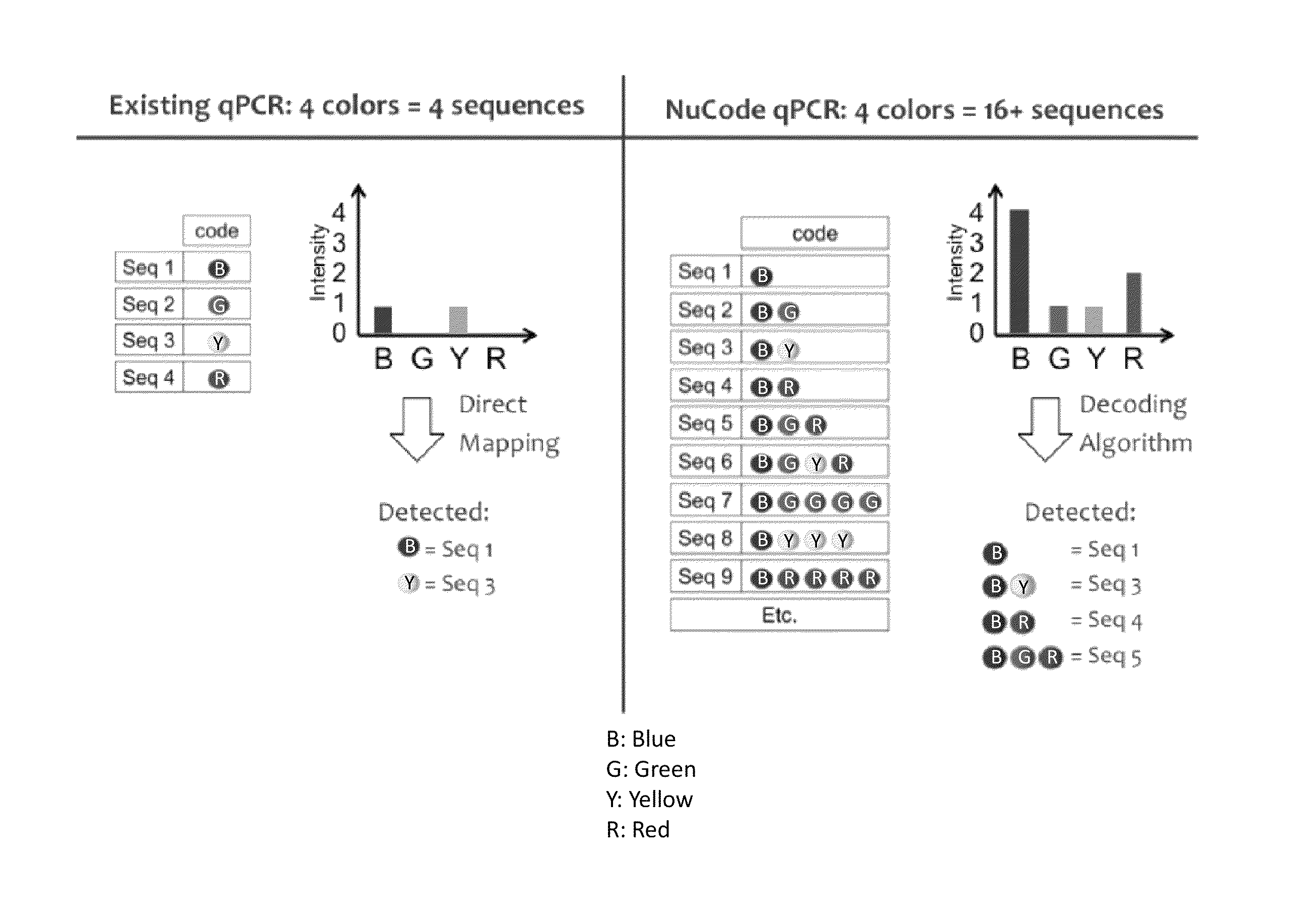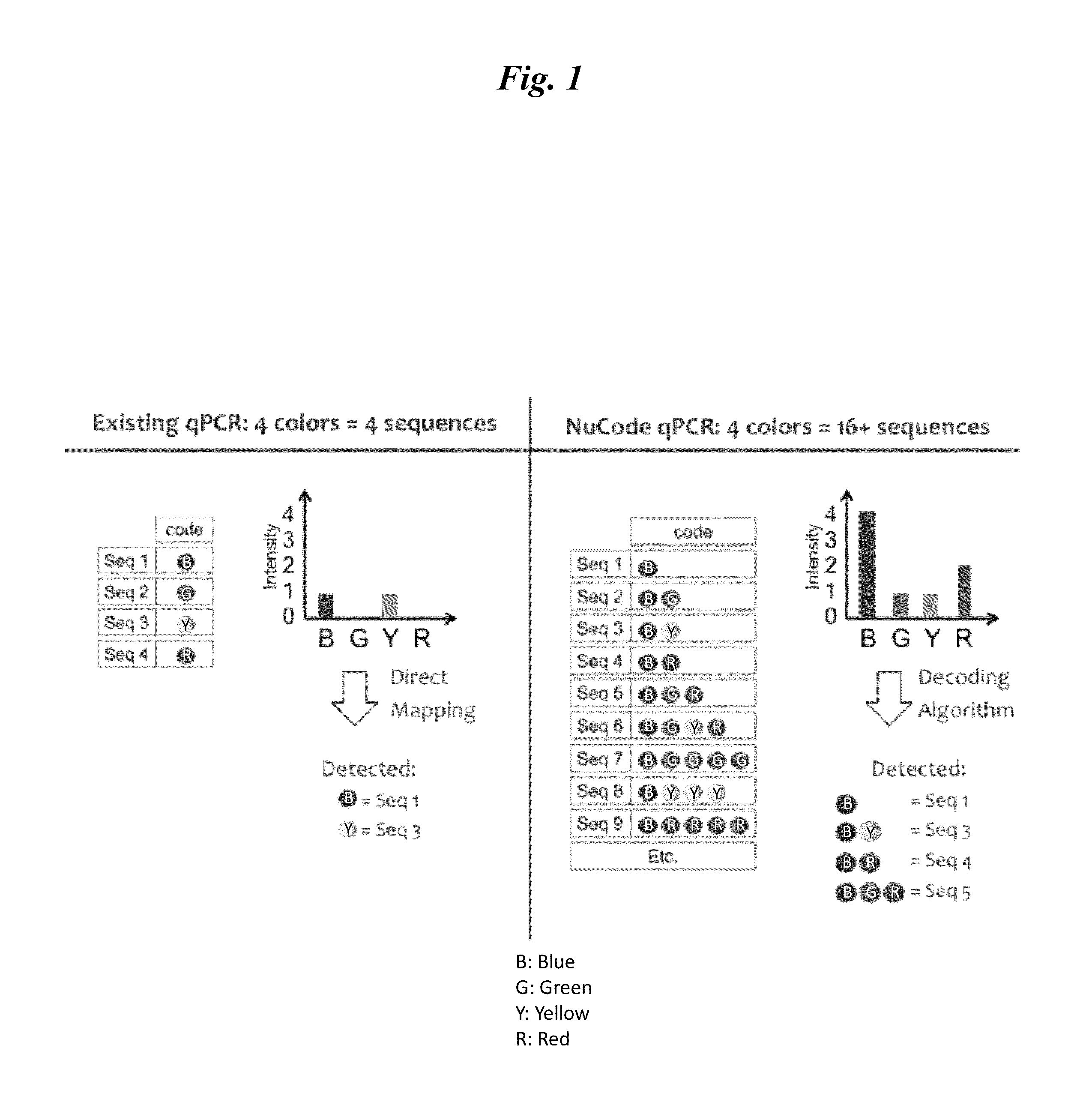Signal encoding and decoding in multiplexed biochemical assays
a biochemical assay and sign encoding technology, applied in the direction of fluorescence/phosphorescence, material analysis through optical means, instruments, etc., to achieve the effect of eliminating degeneracy
- Summary
- Abstract
- Description
- Claims
- Application Information
AI Technical Summary
Benefits of technology
Problems solved by technology
Method used
Image
Examples
example 1
General Materials & Methods
1. General Reagents
[0181]TE Buffer, pH7 (LIFE TECHNOLOGIES, Carlsbad, Calif.); UltraPure RNAse-free Water (LIFE TECHNOLOGIES, Carlsbad, Calif.); Taq 5× Master Mix (FISHER SCIENTIFIC COMPANY, Tustin, Calif.).
2. DNA Sequences, Primers, and Probes
[0182]Five nucleic acids from organisms of clinical relevance were chosen for the exemplary study: (1) human immunodeficiency virus 1 (HIV-1); (2) Plasmodium falciparum (Malaria); (3) herpes simplex virus-2 (HSV-2); (4) Mycobacterium tuberculosis (TB); (5) and dengue virus type 3 (dengue fever).
[0183]Two regions of diagnostic relevance from the HIV-1 genome, p17 and poly-protease, were selected from the Los Alamos National Laboratory HIV-1 reference sequence. A diagnostic sequence from the Plasmodium falciparum ChR7 gene was obtained from the UCSC Plasmodium falciparum Genome Browser. A sequence for Herpes Simplex Virus-2 was synthesized from the sequence obtained from the European Molecular Biology Library. Similarl...
example 2
Simultaneous Detection of Polynucleotide Markers from Pathogens Based on an Encoding Method Using More than One Color Per Analyte
[0192]This example describes the simultaneous detection of up to four polynucleotides selected from HIV (2 polynucleotides), HSV-2, Mycobacterium, Plasmodium, and dengue virus. Fourteen PCR reactions were assembled, using the reagents described in Table 15.
[0193]
TABLE 15Reagents for 14 PCR reactions.ReactionType ofConcen-No.ReagentReagenttrationVolume1UltraPure Water—34μLTaq 5x Master Mix—42μLTemplatePoly Protease Template17nM2μLPrimersPoly Protease FWD Primer1nM2μLProtease RVS Primer1nM2μLProbePoly Protease Probe 11nM2μL2UltraPure Water—28μLTaq 5x Master Mix—42μLTemplatesMalaria Template15nM2μLHerpes Template17nM2μLTB Template16nM2μLDengue Virus Template17nM2μLPrimersPoly Protease FWD Primer1nM2μLProtease RVS Primer1nM2μLProbePoly Protease Probe 11nM2μL3UltraPure Water—32μLTaq 5x Master Mix—42μLTemplateMalaria Template15nM2μLPrimersMalaria FWD Primer1μM2μ...
example 3
Simultaneous Detection of Polynucleotide Markers from Pathogens Based on an Encoding Method Using One Color Per Analyte and Different Intensities
[0202]This example describes the simultaneous detection of up to three polynucleotides selected from dengue virus, HIV p17, and HIV polyprotease. The coding scheme was as depicted in Table 11. As shown in Table 17, each analyte was encoded as a single value of fluorescence intensity in a single color. In this case, as described elsewhere in this disclosure, the coding scheme is non-degenerate by design. This is achieved by assigning an intensity value to each analyte that is equal to the cumulative intensity values for the prior analytes, plus one. Of course, as described elsewhere in the specification, the initial assigned value can be greater than one, for example to better distinguish over noise. Similarly, the values assigned to each analyte can be greater than the cumulative intensity values for the prior analytes plus one, for example...
PUM
| Property | Measurement | Unit |
|---|---|---|
| excitation wavelength | aaaaa | aaaaa |
| volume | aaaaa | aaaaa |
| mass spectrometry | aaaaa | aaaaa |
Abstract
Description
Claims
Application Information
 Login to View More
Login to View More - R&D
- Intellectual Property
- Life Sciences
- Materials
- Tech Scout
- Unparalleled Data Quality
- Higher Quality Content
- 60% Fewer Hallucinations
Browse by: Latest US Patents, China's latest patents, Technical Efficacy Thesaurus, Application Domain, Technology Topic, Popular Technical Reports.
© 2025 PatSnap. All rights reserved.Legal|Privacy policy|Modern Slavery Act Transparency Statement|Sitemap|About US| Contact US: help@patsnap.com



